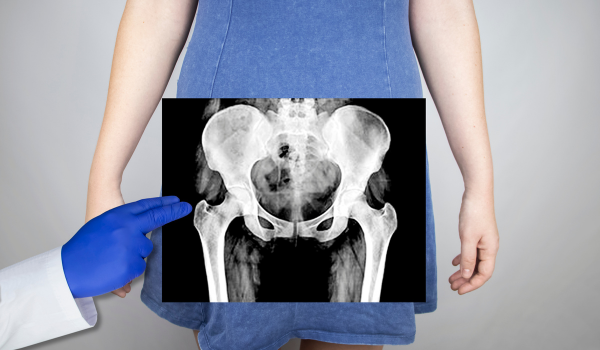.png)
What Is May-Thurner Syndrome?
May-Thurner Syndrome (MTS), also called iliac vein compression syndrome, is a vascular condition that occurs when the right iliac artery compresses the left iliac vein. This compression can slow or obstruct blood flow in the left leg, leading to swelling, pain, or even deep vein thrombosis (DVT).
Though it’s often underdiagnosed, MTS can have serious consequences if left untreated. Understanding what causes this condition begins with a close look at human anatomy and the unique vascular structures involved.
The Anatomy Involved
The human body’s circulatory system includes arteries (which carry oxygenated blood from the heart) and veins (which return deoxygenated blood back to the heart). In the pelvic area, the right common iliac artery crosses over the left common iliac vein.
This crossing occurs in a tight space in the lower abdomen. In some people, the artery presses the vein against the lumbar spine. Over time, this can cause narrowing of the vein, restricting blood flow from the left leg.
This anatomical compression is the core cause of May-Thurner Syndrome.
Why Only One Side?
One of the defining features of MTS is that it affects the left leg much more frequently than the right. This is due to the natural position of the left common iliac vein and its proximity to the overlying right common iliac artery.
As the artery pulsates with each heartbeat, it can slowly wear down the vein wall. Scar tissue may form, thickening the vein and narrowing its passage. Since the same compression doesn’t happen on the right side, MTS remains largely a left-sided condition.
Arterial Pulsation Effects
The long-term effects of the artery’s pulsation are a key reason MTS develops. As the artery continues to press and pulse against the vein, it can cause:
-
Endothelial irritation: Damage to the vein’s inner lining
-
Fibrous band formation: Tissue builds up inside the vein, further narrowing the lumen
-
Turbulent flow: The compressed area may cause blood to swirl or slow down, increasing clotting risk
This chronic mechanical pressure creates an environment ripe for vein dysfunction and, eventually, thrombosis.
Congenital Factors
Some individuals are born with anatomical features that make them more susceptible to developing MTS. These include:
-
A narrower pelvic inlet
-
An unusually positioned iliac vein or artery
-
A congenital web or septum within the vein
These inherited or developmental variations can increase the likelihood of the left iliac vein becoming compressed during adulthood.
Trauma and Injury
Trauma can play a role in the onset of May-Thurner Syndrome. Injuries that shift pelvic anatomy or cause inflammation can aggravate or initiate compression. These may include:
-
Pelvic fractures
-
Surgery in the lower abdomen or pelvis
-
Blunt trauma (e.g., car accidents)
In some cases, post-surgical scarring can mimic the effects of artery-induced compression.
Hormonal and Gender Factors
MTS appears more frequently in women, especially during the childbearing years. Estrogen may influence vein elasticity and blood clotting tendencies. Other contributing factors include:
-
Pregnancy: Enlarged uterus increases pelvic pressure
-
Hormonal contraceptives: Linked to increased clotting risk
-
Menstrual cycle variations: Hormones can affect blood flow and vessel tone
While MTS can occur in both sexes, the anatomical and hormonal differences make females more vulnerable.
Postural and Lifestyle Influences
Sitting for prolonged periods—particularly with poor posture—can worsen vein compression. Long-term effects of poor posture include:
-
Tight hip flexors and pelvic tilt
-
Reduced blood flow through compressed areas
-
Increased clot formation risk in sedentary individuals
Occupation, exercise habits, and posture awareness all play a role in managing or aggravating MTS symptoms.
Obesity and Compression
Carrying excess body weight increases intra-abdominal pressure. This can:
-
Exacerbate the pressure on the iliac vein
-
Make existing compression more severe
-
Increase inflammation and clot risk
Weight management is a key preventive strategy, especially for those genetically predisposed to vascular issues.
Pregnancy and May-Thurner
Pregnancy is a unique situation that can either reveal or trigger MTS symptoms. During gestation:
-
The uterus expands and presses on the pelvic vessels
-
Blood volume increases by up to 50%
-
Progesterone causes veins to dilate
These changes can make the compression worse, leading to leg swelling, pain, or thrombosis. Pregnant women with MTS need careful monitoring and possibly compression therapy or medication.
Clotting Disorders
Some individuals with blood clotting disorders may not tolerate even mild iliac vein compression. Conditions like Factor V Leiden, Protein C or S deficiency, and antiphospholipid syndrome can increase the risk of thrombosis.
When these patients also have anatomical narrowing from MTS, the risk for DVT multiplies. That’s why comprehensive screening is important when symptoms appear.
Secondary May-Thurner
Secondary MTS occurs when compression is not due to natural artery-vein anatomy but other causes, such as:
-
Tumors or cysts in the pelvis
-
Post-surgical swelling
-
Hematomas (internal bleeding)
In such cases, treating the underlying cause can relieve the vein compression.
How It Progresses
May-Thurner often progresses in stages:
-
Compression without symptoms – Some people have anatomical narrowing with no discomfort.
-
Chronic venous insufficiency – Blood starts pooling in the leg, causing heaviness or fatigue.
-
DVT formation – Clots form due to stagnant blood.
-
Post-thrombotic syndrome – Pain, swelling, and skin changes develop due to long-standing vein damage.
Without intervention, complications can be long-lasting and debilitating.
Typical Symptoms
Not all patients with MTS experience symptoms, but when they do, common signs include:
-
Unilateral leg swelling (usually left)
-
Aching, cramping, or heaviness in the leg
-
Skin discoloration or varicose veins
-
Warmth or tenderness along a vein
-
Visible collateral veins in the abdomen or pelvis
These symptoms often worsen after standing or during physical activity.
Risk of DVT
Deep vein thrombosis is the most feared complication of MTS. Because the compressed vein slows blood flow, clots can easily form. If a DVT breaks off and travels to the lungs, it can cause a pulmonary embolism—a life-threatening emergency.
Understanding what predisposes someone to clot formation helps in early detection and prevention.
Diagnostic Tools
Diagnosing May-Thurner Syndrome typically involves:
-
Ultrasound: Often the first test for leg swelling or suspected DVT
-
CT venography or MR venography: Provides detailed imaging of the pelvic vessels
-
Intravascular ultrasound (IVUS): The gold standard for assessing vein narrowing during catheter procedures
A combination of imaging and clinical history helps confirm the diagnosis and guide treatment.
When to Suspect It
You or your doctor should suspect MTS if:
-
You’ve had a DVT in the left leg without clear cause
-
You’re a young female with unexplained leg swelling
-
Symptoms worsen during menstruation or pregnancy
-
You’ve had recurrent DVTs despite treatment
Even if other risk factors are present, MTS may still be the root anatomical cause.
Importance of Early Detection
Early diagnosis allows for non-invasive or minimally invasive treatments like:
-
Blood thinners (anticoagulants)
-
Compression stockings
-
Catheter-directed thrombolysis (to dissolve clots)
-
Stenting to open the compressed vein
Delays in diagnosis can lead to chronic pain, skin changes, and permanent vein damage.
Prevention Strategies
For people at risk or already diagnosed with MTS, preventive steps include:
-
Avoiding long periods of sitting
-
Staying hydrated and active during travel
-
Using compression garments
-
Regular follow-ups with a vascular specialist
Pregnant individuals or those with clotting disorders should consult their doctor early.
Conclusion
May-Thurner Syndrome is a fascinating example of how anatomy alone can lead to serious vascular issues. The compression of the left iliac vein by the right iliac artery, compounded by lifestyle and hormonal influences, sets the stage for symptoms and complications.
Understanding these causes is the first step in preventing DVT and ensuring proper blood flow from the lower limbs. With early detection and appropriate care, most individuals with MTS can lead full and healthy lives.

.png)
.png)
.png)
.png)
.png)
.png)
.png)
.png)



